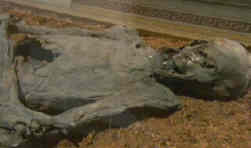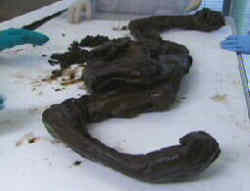Bog Bodies
The remarkably preserved remains of iron-age man
Oldcroghan man, Clonycavan man
In May 2003, Detective Eadaoin Campbell received a call to a crime-scene in County Offaly, Ireland. A body had been found in a peat bog by local workmen. It was soon apparent that the remains were a question for the archaeologists not forensics. These were old remains.
The body, they have decided to call oldcroghan man, is taken to the conservation department of the National Museum of Ireland in Dublin. What they find when they clean to peat away, is not a skeleton, it is a well preserved body. The chemical composition of the peat bog has halted the normal decomposition process. All that remains of the body is the torso and the arms, which are still fleshy and soft to the touch.
Coordinating the project is archaeologist and curator Isabella Mulhall. The team suspect that the body is very old, but as yet they have no way of telling. The headless bog body from Croghan was found naked, apart from a simple plaited leather band around the upper left arm. This was the only artefact found with the body and is unlike anything the team have seen before. Found alongside the body was a withy, a length of hazel branches twisted to form a rope, again remarkably well preserved.
The mystery deepens when they finish cleaning the last of the peat from the body and find tiny fragments of the withy embedded in both of the arms.
The last soft-tissue bog body to be discovered in the Irish peat bogs was in 1978. This was the body of a young woman who the scientists have dated back to the late 16th century.

Gallagh Castle Body, Discovered 1821
A much better known bog body is one found near Gallagh Castle in County Galway in 1821. The body of a young man around 25 years old and dated back to 200-400 BC. While the this body was well preserved when it was discovered, the preservation techniques of the day did not allow it to be maintained in this condition and it has since dried out and deteriorated.
Oldcroghan Man is still fresh and the level of preservation will allow the team to investigate the cause of death. Professor Marie Cassidy is Ireland’s state pathologist and she hopes that modern forensic pathology can shed some light on this ancient murder.

Oldcroghan Man
Cuts to the chest around the nipples and knife marks on the ribs lead Professor Cassidy to the conclusion that this man was tortured, stabbed, beheaded and dismembered before being buried in the peat bog.
Just three months before Oldcroghan Man was found another body was discovered by a peat-cutting machine at Clonycavan, just 25 miles from the Croghan bog. This body is less well preserved than Oldcroghan Man but it does have a head, a head which is still topped with hair. Once the body is cleaned the scientists are intrigued by what appears to be deliberate styling of the hair, but this has concealed something much darker. The skull has been smashed by a sharp object the result of a vicious attack.
Croghan Hill has been a site for Christian ceremonies for hundreds of years including the inauguration of Irish Kings. It has long been believed that these Christian rites are rooted in their earlier Pagan rituals.
Historian, Ned Kelly, investigates early records and finds that both Oldcroghan Man and Clonycavan Man were buried on old tribal borders. Further research reveals records of 40 other bog bodies found, also on tribal borders.
The team still does not know if these remains date from Christian or Pagan times so they arrange for samples to be dated. Radio carbon or carbon 14 dating works best from samples of wood, and the withy found with Old Croghan Man is undeniably linked to the body. Samples of the withy and from the gut of the body are sent to be analysed. Unbelievably both bodies date to 392-175 BC or early Stone Age.